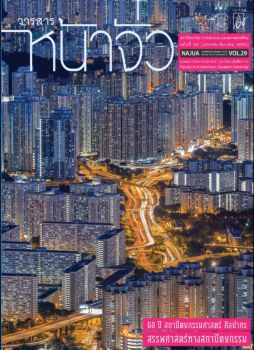เวียงเจ็ดลิน: เมืองโบราณสัณฐานกลม
Keywords:
เวียงเจ็ดลิน, ผังเมืองรูปทรงกลมแบบเรขาคณิต, Wiang Chet Lin, Geometric circular city planAbstract
บทความวิชาการนี้ เป็นการศึกษาเวียงโบราณเชิงดอยสุเทพที่เป็นองค์ประกอบสำคัญทาง ผังเมืองของเมืองเชียงใหม่ โดยมีวัตถุประสงค์เพื่อทำการศึกษาองค์ความรู้เรื่องเวียงเจ็ดลินในมิติ ทางผังเมืองเพื่อนำไปสู่การอนุรักษ์และพัฒนา ผลการศึกษาพบว่า เวียงเจ็ดลินมีลักษณะพิเศษทาง ผังเมือง คือ รูปทรงกลมแบบเรขาคณิตที่มีจุดศูนย์กลางเป็นตานํ้า นับเป็นภูมิปัญญาที่แตกต่างจาก การสร้างเมืองโบราณทั่วไปในล้านนาและในประเทศไทย ทำเลที่ตั้งเป็นชัยภูมิที่ดีต่อการรบ ใกล้ป่า ที่เป็นแหล่งทรัพยากรและมีแหล่งนํ้าอุดมสมบูรณ์ มีสภาพแวดล้อมทางธรรมชาติที่สวยงาม จึงเป็น เวียงบริวารร่วมสมัยกับเมืองเชียงใหม่ที่มีประโยชน์ใช้สอยเพื่อพักผ่อนตากอากาศ และช่วยรบยามมี ศึกสงคราม ส่วนข้อจำกัดต่อการอนุรักษ์และพัฒนา คือ ขาดองค์ความรู้เรื่องเวียงเจ็ดลิน ไม่ปรากฏ หลักฐานทางสถาปัตยกรรม และไม่สามารถมองเห็นภาพรวมของรูปทรงผังเมืองที่เป็นลักษณะพิเศษ ได้ด้วยจากทัศนียภาพ ปัจจุบันมีการใช้ประโยชน์ที่ดินของวัดและส่วนราชการหลายหน่วยงาน ดังนั้น หากรีบไม่ดำเนินการอนุรักษ์ และพัฒนาอย่างเป็นรูปธรรมก็จะเสี่ยงต่อการสูญเสียมรดกทางวัฒนธรรม ที่มีคุณค่าต่อเมืองเชียงใหม่และคุณค่าด้านผังเมืองไปอย่างน่าเสียดาย
Wiang Chet Lin: Geometric Circular Town
Isara Guntang
Lecturer, The Faculty of Art and Architecture Rajamangala University of Technology Lanna
This article presents the study of an ancient town at the foot of Doi Suthep Mountain as an important component of the Chiang Mai City Plan with the objective of gaining the knowledge about the old town of Wiang Chet Lin in relation to the city plan for conservation and development. The findings are that Wiang Chet Lin has a unique plan of a geometric circular shape with a water spring at the center. This is quite a different way of thinking or wisdom found in relation to other ancient cities in Lanna as well as those of other areas in Thailand. It reflects a proper strategic location in case a battle occurred as it was near the forests which ensured good natural resources and abundant water. In addition, it appeared to have very beautiful natural surroundings. As such, it became a subordinate ancient town contemporary to Chiang Mai City perfect for recreation and battle strategy. However, there seemed to be some limitations in terms of conservation and development due to the lack of knowledge and architectural evidence of the town to give a clear overview of its unusual plan through visual perception. Moreover, the land was exploited by some temples and government agencies. Therefore, it is urgent to take action for concrete conservation and development to avoid the risk of losing a valuable cultural heritage of Chiang Mai and eventually losing some useful knowledge on city planning.





